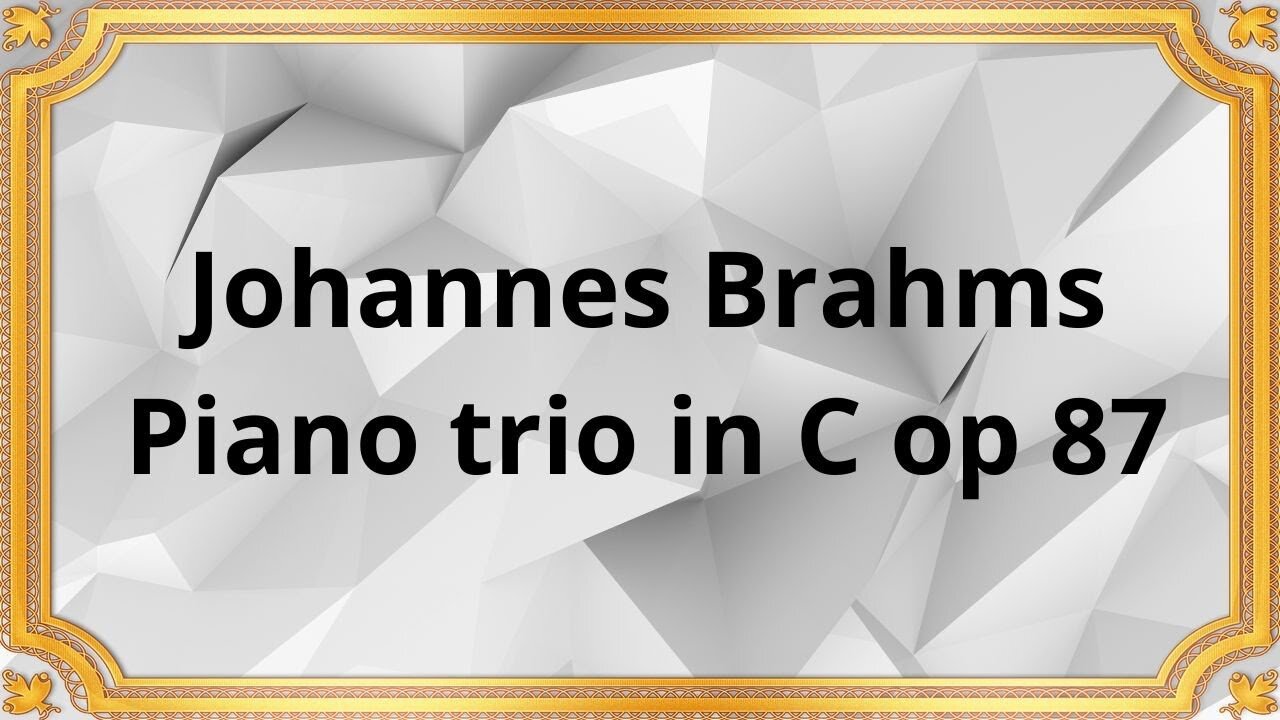Premium Only Content

Johannes Brahms Piano trio in C op 87
#Brahms #ClassicalMusic #PianoTrio #CMajor #Opus87 #MusicalComposition #Composer #JohannesBrahms
Publication date 1929
Hirt Trio:
Franz-Joseph Hirt, piano
Alphonse Brun, violin
Lorenz Lehr, cello
Johannes Brahms' Piano Trio in C, Op. 87, is a remarkable and influential composition that exemplifies the genius and mastery of one of the most celebrated composers of the Romantic era. Written in 1882, this piano trio stands as a testament to Brahms' profound musicality and his ability to create works of depth and emotional richness.
The Piano Trio in C, Op. 87, is a four-movement work that showcases Brahms' distinctive style and his deep understanding of chamber music. The first movement, marked Allegro, opens with a bold and passionate theme presented by the piano. The string instruments, the violin and cello, then join in, engaging in a musical dialogue with the piano. The movement exhibits Brahms' characteristic use of rich harmonies, intricate counterpoint, and compelling melodies that are developed throughout the movement. The interplay between the instruments creates a sense of drama and intensity, captivating the listener from the very beginning.
The second movement, marked Andante con moto, offers a contrasting mood of lyrical beauty and introspection. It begins with a hauntingly beautiful melody presented by the cello, accompanied by the piano. The violin then takes up the melody, creating a sense of dialogue and musical conversation. Brahms' mastery of expressive and emotive writing is evident in this movement, as he weaves together the voices of the three instruments, creating a profound sense of longing and introspection.
The third movement, marked Scherzo: Presto, is a lively and energetic dance-like movement that showcases Brahms' rhythmic inventiveness and his ability to create captivating and virtuosic passages. The movement is characterized by its playful and spirited themes, rapid passages, and intricate interplay between the piano and the strings. Brahms' skillful use of dynamics and contrasting sections adds depth and excitement to this movement, captivating the listener with its energy and technical brilliance.
The final movement, marked Allegro giocoso, brings the Piano Trio to a triumphant and exhilarating conclusion. It is a vibrant and spirited movement, filled with rhythmic drive, catchy melodies, and moments of virtuosic brilliance. Brahms' use of contrapuntal techniques, such as canonic writing, adds complexity and depth to the music, creating a thrilling and satisfying finale.
Johannes Brahms' Piano Trio in C, Op. 87, is a testament to the composer's exceptional skill in crafting chamber music of profound emotional depth and complexity. Through its four movements, this piano trio showcases Brahms' mastery of form, his gift for melody, and his ability to create a wide range of emotions in his compositions.
This musical masterpiece continues to captivate audiences with its timeless beauty and enduring appeal. Its rich harmonies, expressive melodies, and intricate interplay between the piano and strings make it a cherished work in the chamber music repertoire. Brahms' Piano Trio in C, Op. 87, stands as a testament to his musical genius and serves as a reminder of his significant contributions to the world of music.
In conclusion, Johannes Brahms' Piano Trio in C, Op. 87, is a magnificent and influential composition that exemplifies the composer's profound musicality and his ability to create works of exceptional depth and emotional richness. Through its four movements, this piano trio showcases Brahms' mastery of form, his gift for melody, and his unique ability to evoke a wide range of emotions in his compositions. It remains a cherished and celebrated piece in the classical music canon, forever reminding us of Brahms' extraordinary talent and his lasting impact on the world of music.
You have the opportunity to support the channel https://destream.net/live/RadSiarAl/donate
-
 32:30
32:30
Classical music_Music Inspiration
15 days agoArturo Toscanini Grand Canyon Suite
521 -
 LIVE
LIVE
LFA TV
12 hours agoLFA TV ALL DAY STREAM - WEDNESDAY 6/4/25
2,150 watching -
 1:25:29
1:25:29
JULIE GREEN MINISTRIES
3 hours agoLIVE WITH JULIE
90.7K157 -
 1:40:14
1:40:14
Chicks On The Right
4 hours agoElon RIPS BBB, Hakeem still ranting about Project 25, & lack of pride merch is fascism
9.8K2 -
 1:39:17
1:39:17
Bitcoin on Rumble
1 hour agoBBB, Brrrr and Bitcoin
8.76K2 -
 2:05:45
2:05:45
AP4Liberty
2 hours ago $0.67 earnedElon Musk Calls Trump Megabill a ‘Disgusting Abomination’
7.95K2 -
 29:12
29:12
Producer Michael
20 hours agoTOURING A $13,750,000 LAS VEGAS MEGA MANSION WITH SPECTACULAR VIEWS OF THE STRIP!
39K8 -
 1:37:10
1:37:10
Nick Freitas
17 hours agoWhat We've Learned Through 26 Years of Marriage
24.3K2 -
 2:00:56
2:00:56
BEK TV
1 day agoTrent Loos in the Morning 6/4/2025
12.1K -
 24:56
24:56
Brandon Lutnick
5 days agoBitcoin 2025: Brandon Lutnick and Paolo Ardoino fireside chat
38.4K4